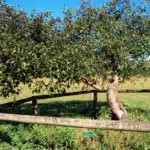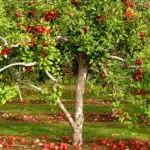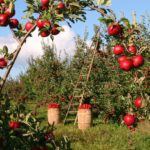Growing an apple tree from seed is a rewarding and satisfying experience. Not only do you have the satisfaction of creating something with your own hands, but you will be able to enjoy the delicious fruits of your labor for years to come. As a specialist in botany and gardening, I’m here to explain the steps needed to successfully grow an apple tree from seed.
The task of growing an apple tree from seed may seem daunting at first, but with the right information and knowledge it can be done easily. There are many benefits that come when you grow an apple tree from seed; these include lower cost than purchasing a young sapling, and the ability to customize your own variety of apples.
You don’t need any special tools or equipment to get started, just some patience as you wait for your new apple tree to grow and bear fruit! In this article I’ll explain the steps needed to successfully grow an apple tree from seed so that anyone can enjoy their own homegrown apples in no time!
Selecting The Right Seeds For Apple Tree Growing
Surprisingly, it is possible to grow an apple tree from the seeds of an apple. In fact, only 1 in 10,000 apple seedlings will be true to the parent variety. This means that you have to select the right seeds for growing an apple tree if you want a successful result.
For successful growth of an apple tree from seed, it is important to choose healthy and viable seeds. As a specialist in botany and gardening, I recommend finding a ripe apple with good flavor and texture and then carefully removing the seeds from within. Once done, discard any soft or bruised seeds as these are unlikely to germinate.
The remaining seeds should be placed in a moist paper towel inside a sealed plastic bag for two weeks until there are signs of germination. The ideal temperature for germination should not exceed 68 degrees Fahrenheit (20 degrees Celsius). After this point, you can now prepare them for planting by lightly sanding them to remove any waxy coating that may exist on the surface, which can hinder growth.
With this preparation complete, your apple tree seedlings are ready for planting!
Preparing The Seeds For Planting
Preparing the seeds for planting is an essential step in the process of growing an apple tree from seed. It is important to properly prepare the seeds prior to planting, as this ensures that they have the best chance of germinating successfully.
First, it is important to remove any husks or protective layers that surround the seed. This can be done by lightly rubbing the seed between your fingers in a gentle manner. Once removed, place the seeds into a bowl of lukewarm water and allow them to soak for about 24 hours. This will help soften up the hard outer layer of the seed and make it easier for it to break down during germination.
After soaking, you should then plant each individual apple seed into a pot filled with potting soil. Make sure that you press each seed firmly into the soil so that it makes good contact with the surface. Also, ensure that each pot has proper drainage holes at its base for excess moisture to escape through. Finally, water each pot lightly and place them in a warm location where they will receive plenty of indirect sunlight throughout the day.
By following these steps carefully, you can provide your apple tree seeds with an optimal environment for successful germination and growth. With some patience and dedication, you’ll soon be able to watch your own little apple tree begin to take shape over time! By choosing a suitable location for planting, you’ll be one step closer to having your very own homegrown apples!
Choosing The Best Location For Planting The Seeds
Choosing the best location for planting apple tree seeds is a critical step in successfully growing one. It’s like placing the very foundation of your future tree – it sets up the rest of growth. With careful consideration, you can optimize this crucial step and give your seedling a head start on healthy development.
When selecting a spot to plant apple seeds, there are several factors to consider. First and foremost, choose an area that receives full sun with warm temperatures throughout the day. Apples need at least six hours of direct sunlight each day to achieve optimal growth. Additionally, make sure the soil is well-draining and has ample amounts of organic matter; loam or sandy loam soils are ideal for apple trees.
Lastly, ensure your chosen location isn’t too close to other trees or buildings as this can block light and airflow to your seedling. If possible, pick a spot that’s sheltered from strong winds and provides good drainage in case of heavy rains or flash floods. By taking all these aspects into account when making a decision, you’ll be setting yourself up for success in starting an apple tree from seed!
Preparing The Soil For Planting Apple Seeds
Planting an apple tree from seed is a labor of love, but if you put in the effort you can have a fruitful reward. Taking the time to properly prepare the soil for planting the seeds is essential for success. To get your apple tree off to a good start, here are some tips to ensure it will get all the nutrients it needs.
The first step in preparing the soil is to choose an area with well-draining soil and plenty of direct sunlight. You’ll also need to check that there’s enough room for your tree’s roots to spread out as it grows. Once you’ve decided on a spot, test your soil pH levels and adjust accordingly so that they’re within 6 – 8 range for optimal growth. It’s important to incorporate organic matter into your soil like compost or manure too, as this will help increase water retention and add essential nutrients needed for healthy development.
Finally, make sure that the soil is loose and free of debris before planting so that your tree can easily absorb water and other necessary minerals. When done correctly, this process should give your apple tree its best chance at thriving in its new home.
Planting The Apple Seeds
Taking the plunge and planting apple seeds is like a beautiful dream come true for any gardening enthusiast. Planting these seeds can be a thrilling experience, as the outcome is uncertain and unknown! There are several steps to consider when planting apple seeds that will help ensure your success.
First and foremost, you’ll want to make sure that you select an ideal spot for planting the apple seeds. The soil should be loose and deep enough to allow for proper root growth. If possible, it’s also best to avoid areas with heavy shade or waterlogged soils. Additionally, it’s important to prepare the soil before planting by adding organic matter such as compost or manure to enhance its structure and fertility.
Once you have chosen the right spot and prepared the soil accordingly, you can plant your apple seeds! Simply take each seed individually and place them in small holes that are at least one foot apart from each other. Make sure to cover them lightly with soil so they are just barely covered – too much soil can suffocate them! Water thoroughly after planting to ensure good seed-to-soil contact.
With all this groundwork in place, your journey into growing an apple tree from seed is off to an exciting start! Now it’s time to focus on watering and mulching the apple seeds for optimal growth.
Watering And Mulching The Apple Seeds
Now that the apple seeds have been planted, it is time to move on to the next step in their growth: watering and mulching. This step is essential to ensure that your new tree will get off to a healthy start and will develop into a strong tree with plenty of fruit.
When watering your apple seeds, make sure you use enough water for them to be evenly moistened, but not so much that they are sitting in standing water. Mulch is also important for providing insulation and moisture control around the seedlings. Bark mulch works well for this purpose; it will help keep the soil temperature even and prevent drying out of the young roots.
It’s crucial to remember that while these two steps seem simple, they can make or break your success with growing an apple tree from seed. Paying attention to both aspects of watering and mulching will ensure your apple tree has enough nourishment and protection needed for its early stages of growth so that it can mature into a fully grown tree ready for harvesting those delicious apples!
Understanding The Growth Stages Of Apple Trees
Watching apple trees sprout from seed can be as exciting as it is rewarding. It’s like watching a tiny life form taking shape, and the growth stages of an apple tree are just as fascinating. From germination to flowering, let’s explore the journey of an apple tree from seed.
The very first step in growing an apple tree is germination. The seeds must be moistened and placed in a warm environment for them to begin their journey to becoming a sapling. Once they have begun to sprout, the next stage is vegetative growth. This phase involves the seedling pushing up through the soil and establishing itself by forming roots and leaves. During this period, it is important that the young tree has access to enough light and water for it to thrive.
As the tree continues to mature, it will then enter its reproductive phase. The apple blossoms will start to appear and this will mark the beginning of a new chapter in its development cycle. These flowers may even attract pollinators such as bees or birds which can help with fertilization of the plant’s fruit-bearing site. With patience and care, you will soon have your own homegrown apples!
Now that we’ve understood the different stages of growing an apple tree from seed, it’s time to move on to pruning and training young apple trees so they can produce delicious fruits season after season!
Pruning And Training Young Apple Trees
Pruning and training young apple trees is an important part of the journey to a mature, fruitful apple tree. To ensure successful growth and fruiting, it is essential to understand the best methods for pruning and training.
Pruning involves removing branches that are dead, diseased or crossing over each other, while trimming back branches to create a strong framework will help your tree grow quickly. Here are some key points to consider when pruning:
- Removing Deadwood: Cut away any dead, broken or diseased branches back to their point of origin. This will help maintain the health of your apple tree and provide more space for healthy new growth.
- Training Young Branches: Young branches should be trained in an open-vase shape structure so that sunlight can reach all parts of the tree. This helps promote even growth throughout the crown and encourages fruiting.
- Shaping: As your tree matures, you may need to shape its crown by cutting off any shoots that are growing outwards or upwards at an awkward angle. Doing so will give your tree a balanced shape and prevent it from becoming too unruly.
Training young apple trees also involves tying them up with supports such as wires or stakes in order to keep them upright during windy conditions. It is important not to tie too tightly as this can damage the bark of the tree, but rather just enough to provide enough support without constricting movement too much. It is also essential to check these ties regularly and replace them when they become loose or damaged.
The next step in growing a fruitful apple tree is ensuring adequate sunlight for optimal growth – but more on that later…
Ensuring Adequate Sunlight For Apple Trees
When it comes to growing apple trees, one of the most important components is adequate sunlight. Just like humans, plants need access to sunlight to survive and thrive. For example, imagine a plant living in a dark room with no windows – it would eventually wither away without the necessary light to sustain its life.
The same concept applies to apple trees. Apple trees need an abundance of sunlight for proper growth and fruit production. Without sufficient light, the tree will struggle and may not produce any fruit at all. If you want your apple tree to reach its full potential then make sure it receives ample amounts of sunlight each day. The ideal amount for apple trees is about 6-8 hours per day during the growing season.
If you’re planting your apple tree in a shaded location or if there are buildings or other obstacles blocking some of its sunshine, consider pruning nearby branches or adding additional lighting in order to provide enough light for your tree’s needs. By ensuring that your apple tree has access to plenty of sunshine, you can help ensure that it grows vigorously and bears abundant fruit year after year.
Understanding The Soil Needs Of Apple Trees
They say ‘you are what you eat’ and this phrase could not be more true for apple trees. As with all plants, soil is the foundation upon which successful growth will depend. Understanding the soil needs of apple trees is essential in order to get the best out of your tree.
The pH level of the soil can have an impact on how well your tree grows. An ideal pH range for these trees is 6-7, as this replicates their natural environment in areas such as New England orchards. If the pH level is too low, it can prevent important nutrients from being available to the tree and stunt its growth. Additionally, organic matter should be added to enrich soil composition for better aeration and drainage capabilities.
It’s also important to check if your soil has enough nutrients, such as nitrogen and potassium. Nitrogen helps a tree grow strong foliage while potassium assists with flower formation during blooming season. Adding mulch around your apple tree will help conserve moisture and reduce competition from weeds that may take away vital nutrients from the soil.
Finally, it’s important to ensure that your apple tree has access to enough water throughout its growing season so that its roots have a consistent supply of nutrients and moisture when needed. With adequate sunlight, nutrient rich soil, and proper watering practices, you’ll soon be able to enjoy an abundance of delicious apples!
Recognizing Common Apple Tree Pests And Diseases
Apple trees are a truly remarkable species, able to withstand the toughest of climates and produce some of the most delicious fruits. But they are susceptible to pests and diseases that can damage their growth and production. It is estimated that over 10% of global apple tree crops are affected by pests and diseases each year. As a botany specialist and gardener, it is important for me to provide guidance on recognizing these issues.
When it comes to apple tree pests, it’s helpful to keep an eye out for mites, aphids, caterpillars, and borers because they can all cause significant damage to leaves, fruit buds, and bark if left unchecked. Diseases such as fire blight, scab, powdery mildew and rust can also affect the overall health of your trees. These problems can be identified by discoloration or wilting of leaves or branches as well as the presence of lesions or spots on the fruit or bark.
The key is to pay attention to your trees regularly so you can spot any signs early before they spread further in the tree or garden. If you notice any signs that these pests or diseases are present, take action right away. Depending on the severity of the problem, this may involve pruning off infected parts or using chemical sprays specifically designed for controlling pest outbreaks in apples.
By being aware of these common apple tree pests and diseases along with taking preventive measures when needed, you will be better equipped with preserving healthy apple trees in your garden!
Fertilizing Apple Trees
Fertilizing apple trees is an essential part of cultivating a healthy, abundant crop of apples. It helps to provide the tree with all the nutrients it needs to produce delicious fruit. But fertilizer isn’t just about giving your apple tree what it needs; proper fertilization also helps protect against pests and diseases that can damage your tree and limit its production. As such, fertilizing your apple tree should be part of your regular maintenance program.
When choosing a fertilizer for your apple tree, it’s important to select one formulated specifically for fruit trees. This type of fertilizer will contain higher levels of nitrogen and other essential nutrients, as well as micronutrients like magnesium and zinc, which are important for strong fruit development. You should also look for a slow-release fertilizer that will help ensure that the nutrients remain available throughout the growing season.
Finally, apply the fertilizer according to package instructions in early spring (around mid-March) and again in mid-summer (early July). This will help ensure that your apple tree has all the nutrients it needs during its active growing season while also protecting against pests and disease throughout its life cycle. With proper fertilization and care, you’ll be harvesting apples off your own tree in no time!
Harvesting Apples From Apple Trees
Harvesting apples from apple trees is an incredible feeling! It’s like getting to take a bite out of a delicious piece of fruit that you’ve nurtured and grown yourself. As any specialist in botany and gardening will tell you, it’s a rewarding experience that should be savored.
When harvesting apples, timing is key. You’ll want to pick the apples when they are at their peak ripeness – not too early or too late. This means paying attention to the size, color, and texture of the fruit. A ripe apple will be juicy and tender to the touch. To test if it’s ready for picking, give it a gentle twist – if it comes off easily with no resistance, then it’s time to harvest!
Once you have your basket full of freshly picked apples, there are a few things you can do with them. Of course, you can eat them right away – nothing beats fresh-from-the-tree flavor! But if you’d like to store them for later use, there are some great ways to preserve their flavor and texture for months on end. We’ll explore those options in the next section.
Storing And Preserving Apples From Apple Trees
Once you’ve harvested apples from your apple tree, it’s time to think about storage and preservation. For example, let’s take the case of John. John recently harvested a large crop of apples from his apple tree and now needs to find the best way to store them for upcoming months. As a specialist in botany and gardening, I’m here to tell you that storing and preserving apples is an important step in maintaining the quality of your harvest.
The first step for successful storage is choosing the right container for your apples. A cool, dark place with plenty of ventilation is ideal; wooden boxes or crates are great options as they provide adequate air circulation while protecting your fruit from pests. Additionally, be sure to inspect each apple carefully before packing them away – discarding any bruised or damaged fruits so that they don’t spoil other healthy apples nearby.
When storing apples, it’s also important to keep moisture levels low by using dry materials such as newspaper or sawdust between layers. This will help prevent mold growth while keeping the fruit fresh and flavorful until you’re ready to eat them! Additionally, if you want to extend the shelf life even further, consider freezing or canning some of your harvest; both methods can help preserve vitamins and nutrients while providing delicious snacks all year round.
Storing and preserving apples properly helps ensure that you get the most out of your harvest. With a little bit of effort and planning, you can keep fresh apples on hand for months after you’ve picked them from the tree!
Tips For Successfully Growing An Apple Tree From Seed
Growing an apple tree from seed is not for the faint of heart. It can be difficult and requires patience and dedication. However, with a bit of guidance and the right tips, you can be successful in growing your own apple tree from seed. Here are some tips to help you succeed.
First, choose a good quality seed that has been cold-stratified for at least two months; this will ensure that the seeds are viable and ready to germinate. Next, prepare the soil for planting by tilling it up to 12 inches deep and adding organic material such as compost or manure to provide nutrients for the new plant. Make sure to plant the seeds in a sunny spot with well-draining soil so they have ample opportunity to grow.
Lastly, provide your apple tree with plenty of water while it is young in order to encourage strong root growth. Additionally, mulching around the base of the tree will help keep moisture in the soil and protect its roots from extreme temperatures. Finally, prune your tree regularly throughout its life cycle in order to promote healthy growth and increase fruit production. With these tips, you’ll have a better chance at successfully growing an apple tree from seed!
Frequently Asked Questions
How Long Does It Take To Grow An Apple Tree From Seed?
Growing an apple tree from seed may sound like a daunting task, but it is actually quite simple. Many people believe that growing an apple tree takes years and years, but the truth is that it can be done in just a few months. Of course, the success of the endeavor depends on how well the seeds are taken care of and how hospitable their environment is.
As a specialist in botany and gardening, I would advise anyone who wishes to grow an apple tree from seed to be patient and prepared for their journey. The seeds will need to be cleaned, soaked in water overnight, and then planted in a pot filled with soil. Once this has been done, the pot should then be placed in a warm area where it can receive enough sunlight for at least 6 hours per day.
The next step is to keep a close eye on the progress of the seedling as it grows into an apple tree. Watering should be done regularly and pruning should also take place when necessary. With proper care and attention, you can expect your apple tree to reach maturity within 3-4 months of germination – which is much faster than many people believe!
Apple trees are not only beautiful additions to any garden or backyard, they are also incredibly beneficial for our environment as they provide food sources for wildlife and help clean our air by absorbing carbon dioxide. Growing your own apples at home also means that you can enjoy fresh organic fruit without any added chemicals or preservatives – making it an excellent choice for those looking to live healthier lives!
What Is The Best Time To Plant Apple Tree Seeds?
As the old adage goes: “The early bird catches the worm”, timing is key when it comes to planting apple tree seeds. The best time to plant apple tree seeds is in the late winter or early spring months, depending on where you live. This is because these times of year are ideal for cold stratification, which helps break dormancy and kickstart germination for apple tree seeds.
It’s important to remember that these steps must be taken before planting your apple tree seed: First, assess the environment where you plan to grow your tree. Make sure it will have plenty of sun and access to water. Then, place your seed in an airtight container filled with moist sphagnum moss or vermiculite and store it in a refrigerator for 3 – 4 months. After this period you can take the seeds out and plant them 1/2 inch deep in soil, preferably with a slightly acidic pH level between 6 – 7.
Finally, once the seedlings have sprouted, ensure they receive enough sunlight and water as they continue to develop into full-grown trees. To help them thrive even more, give them a dose of fertilizer every other month with a 10-10-10 formula during spring and summer months or a 12-4-8 formula during fall and winter months.
TIP: When planting apple tree seedlings outdoors make sure there is adequate space around each one so they can get plenty of sunlight and airflow for optimal growth!
How Often Should I Water An Apple Tree?
Watering an apple tree is like giving it a warm hug – it helps the tree stay healthy and happy as it grows. It’s essential to provide the tree with just the right amount of water at the right times of day, so that it can flourish.
When we think about how often to water an apple tree, we should look to nature for guidance. Apple trees in the wild receive regular rainfall throughout the year; if you’re growing your own apple tree from seed, you should try to mimic this natural process by watering your tree every 7-10 days. However, be sure not to drown your apple tree! As a general rule, it’s better to give your tree less water more frequently than more water less frequently – this will help prevent root rot and other problems.
It’s also important to pay attention to your local weather patterns and adjust your watering schedule accordingly – in hot, dry climates you may need to water more often than once a week; during rainy periods, you can reduce how often you water. You’ll know when it’s time to add some extra moisture when the top two inches of soil feel dry or when leaves start wilting.
TIP: When watering an apple tree, be sure to avoid wetting its foliage as much as possible – this will help protect against diseases like fire blight and powdery mildew.
Are Apple Trees Susceptible To Disease?
In a world where disease is ever-present, it’s important to know the potential for apple trees to be affected by illness. As specialists in botany and gardening, we understand the importance of supporting healthy growth and protecting against potential issues.
Unfortunately, apple trees are vulnerable to a variety of diseases that can affect the overall health of the tree. These include common fungal problems such as apple scab, fireblight, and cedar-apple rust. They can also be susceptible to bacterial diseases like crown gall or bacterial spot. Insect pests such as aphids and codling moths may also cause harm to apple trees.
It’s best to stay alert when it comes to disease prevention for your apple tree. Regularly check the leaves and branches for any signs of infection, such as discolored spots or wilting foliage. Consider using an appropriate fungicide spray on your tree during periods with high humidity or rainfall; this will help reduce the risk of infection from fungal spores in the air. Finally, make sure your apple tree is growing in well-drained soil with plenty of organic material; this will help keep it healthy and resilient against potential illnesses.
What Is The Best Climate For Growing Apple Trees?
When it comes to growing apple trees, the climate is a key factor. Apple trees require a certain kind of environment to produce quality fruit, and understanding the right conditions can help maximize your harvest. Let’s take a look at what makes a good climate for growing apple trees.
First and foremost, apple trees need cold temperatures in order to set fruit and develop properly. In general, the ideal temperature range for an apple tree is between 32°F (0°C) and 85°F (29°C). This means that if you live in an area with mild winters and hot summers, you should consider planting your apple tree in a microclimate that meets these requirements.
In addition to temperature, there are several other factors that can affect the success of an apple tree: •tHumidity: Apple trees prefer moderate humidity levels for optimal growth; too much moisture can lead to disease issues such as fungal diseases or powdery mildew. •tSoil: Apples thrive in well-drained soil with plenty of organic matter; soil pH should be between 6.0 and 7.5 for best results. •tSunlight: Apple trees need at least six hours of direct sunlight each day during their growing season (May through August). •tRainfall: Apple trees require regular watering throughout the year; however, they should not be subject to excessive rainfall or flooding which can cause stress on the tree. •tWind: Wind helps keep insects away from your apple trees, but too much wind can cause damage by drying out leaves and branches.
Taking all of these factors into consideration will help ensure you create an environment conducive to healthy apple tree growth! By providing adequate water, light and protection from extreme weather conditions such as frost or high winds, you will give your tree the best chance for success. With proper care and maintenance, you’ll be enjoying delicious apples from your own backyard in no time!
Conclusion
The process of growing an apple tree from seed is relatively straightforward, although it does take patience. On average, it can take up to four years before you will see the first signs of fruit. Planting in springtime is ideal, as this gives the seedlings enough time to become established before winter. Watering and a suitable climate are also key factors for successful apple tree growth. It’s important to remember that while they don’t require a great deal of care, apple trees are susceptible to diseases such as fire blight and woolly aphid if not properly maintained.
With the right preparation and attention, however, growing an apple tree from seed can be both a rewarding and cost-effective experience. In fact, studies have shown that trees grown from seeds often produce apples with superior flavor than those purchased at stores or nurseries1. This makes them a great choice for gardeners looking for something special in their landscape or orchard.
In conclusion, growing an apple tree from seed requires patience but can be a highly rewarding experience. From planting in springtime to providing the correct amount of water and a favorable climate, it’s important to pay attention to best practices in order to ensure healthy growth and delicious fruit. With the right steps taken beforehand, you too can enjoy your own home-grown apples!





























